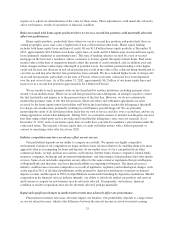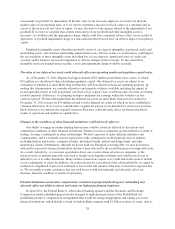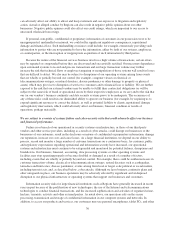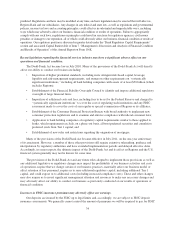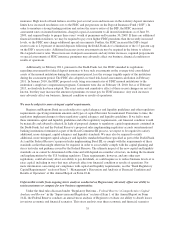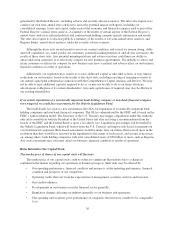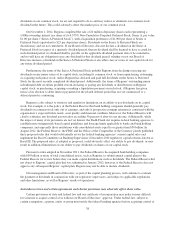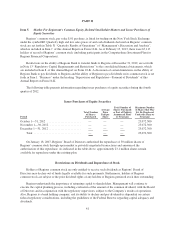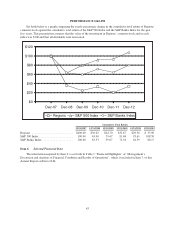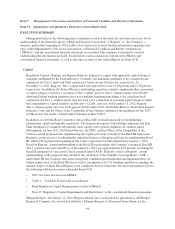Regions Bank 2012 Annual Report Download - page 51
Download and view the complete annual report
Please find page 51 of the 2012 Regions Bank annual report below. You can navigate through the pages in the report by either clicking on the pages listed below, or by using the keyword search tool below to find specific information within the annual report.insurance. High levels of bank failures over the past several years and increases in the statutory deposit insurance
limits have increased resolution costs to the FDIC and put pressure on the Deposit Insurance Fund (“DIF”). In
order to maintain a strong funding position and restore the reserve ratios of the DIF, the FDIC increased
assessment rates on insured institutions, charged a special assessment to all insured institutions as of June 30,
2009, and required banks to prepay three years’ worth of premiums on December 30, 2009. If there are additional
financial institution failures, we may be required to pay even higher FDIC premiums than the recently increased
levels, or the FDIC may charge additional special assessments. Further, the FDIC increased the DIF’s target
reserve ratio to 2.0 percent of insured deposits following the Dodd-Frank Act’s elimination of the 1.5 percent cap
on the DIF’s reserve ratio. Additional increases in our assessment rate may be required in the future to achieve
this targeted reserve ratio. These increases in deposit assessments and any future increases, required prepayments
or special assessments of FDIC insurance premiums may adversely affect our business, financial condition or
results of operations.
Additionally, in February 2011, pursuant to the Dodd-Frank Act, the FDIC amended its regulations
regarding assessment for federal deposit insurance to base such assessments on the average total consolidated
assets of the insured institution during the assessment period, less the average tangible equity of the institution
during the assessment period. The FDIC also adopted a revised risk-based assessment calculation in February
2011. In January 2010, the FDIC proposed a rule tying assessment rates of FDIC insured institutions to the
institution’s employee compensation programs. Comments were due on February 18, 2010, but as of February
2013, no final rule has been adopted. The exact nature and cumulative effect of these recent changes are not yet
known, but they may increase the amount of premiums we must pay for FDIC insurance. Any such increases
may adversely affect our business, financial condition or results of operations.
We may be subject to more stringent capital requirements.
Regions and Regions Bank are each subject to capital adequacy and liquidity guidelines and other regulatory
requirements specifying minimum amounts and types of capital that must be maintained. From time to time, the
regulators implement changes to these regulatory capital adequacy and liquidity guidelines. If we fail to meet
these minimum capital and liquidity guidelines and other regulatory requirements, our financial condition would
be materially and adversely affected. In light of proposed changes to regulatory capital requirements contained in
the Dodd-Frank Act and the Federal Reserve’s proposed rules implementing regulatory accords on international
banking institutions formulated as part of the Basel Committee III process, we expect to be required to satisfy
additional, more stringent, capital adequacy and liquidity standards. We may also be required to satisfy
additional, more stringent capital adequacy and liquidity standards than those specified as part of the Dodd-Frank
Act and the Federal Reserve’s proposed rules implementing Basel III, or comply with the requirements of these
standards earlier than might otherwise be required, in order to successfully comply with the capital planning and
stress test rules and guidance issued by the Federal Reserve. The ultimate impact of the new capital and liquidity
standards on us cannot be determined at this time and will depend on a number of factors, including the treatment
and implementation by the U.S. banking regulators. These requirements, however, and any other new
regulations, could adversely affect our ability to pay dividends, or could require us to reduce business levels or to
raise capital, including in ways that may adversely affect our financial condition or results of operations. For
more information concerning our compliance with capital and liquidity requirements, see the “Bank Regulatory
Capital Requirements” section of Item 7. “Management’s Discussion and Analysis of Financial Condition and
Results of Operation” of this Annual Report on Form 10-K.
Unfavorable results from ongoing stress analyses conducted on Regions may adversely affect our ability to
retain customers or compete for new business opportunities.
Under the final rules discussed under “Regulatory Reforms – Federal Reserve’s Comprehensive Capital
Analysis and Review” in the “Supervision and Regulation” section of Item 1. of this Annual Report on Form
10-K, the Federal Reserve conducts an annual stress analysis of Regions to evaluate our ability to absorb losses
in various economic and financial scenarios. This stress analysis uses three economic and financial scenarios
35


